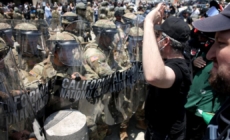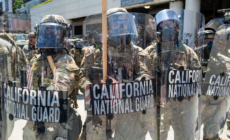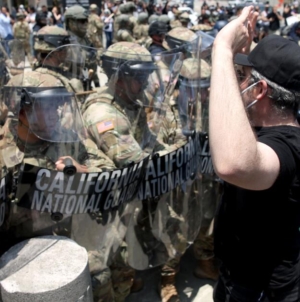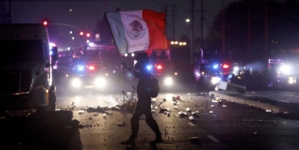-
Dodgers vs. Cardinals Highlights | MLB on FOX - 14 mins ago
-
Dallas Cowboys Coach’s Inspiring Message for Micah Parsons - 20 mins ago
-
Sean ‘Diddy’ Combs seeks mistrial over balcony incident testimony - 29 mins ago
-
First look at preparations for the 2026 FIFA World Cup - 42 mins ago
-
National Guard arrives in L.A. as fallout from raids continues - 53 mins ago
-
‘Unlawful Assembly’ Declared Amid Los Angeles ICE Protests—Police - 59 mins ago
-
Michigan Panthers vs. Birmingham Stallions Highlights | United Football League - about 1 hour ago
-
Miley Cyrus heckled into singing at Tribeca Festival - about 1 hour ago
-
Paramount, a proud Latino suburb, thrust into center of Trump crackdown - 2 hours ago
-
RBC Canadian Open: Full $9.8M Payout, How Much Did Ryan Fox Win? - 2 hours ago
Tourists love Los Angeles. Could the fires change that?
Travelers flying into Los Angeles last weekend were greeted by an apocalyptic sight: billowing clouds of smoke and the red-orange glow of flames against the glittering expanse of city lights.
The stark panorama, and shocking, ubiquitous video of the wildfires, were at sharp odds with images of sun-kissed beaches and glamorous Hollywood that L.A. relies on to draw the flocks of tourists who pump billions of dollars into the local economy each year.
As firefighters begin to bring under control the blazes that laid ruin to Pacific Palisades, parts of Malibu, and the hillside town of Altadena, tourism officials are looking for signs of what short- and long-term toll the disaster may take on L.A.’s prowess as a tourism destination.
“We’re very nervous,” said Jackie Filla, president and CEO of the Hotel Assn. of Los Angeles.
“The first-blush look is obviously there’s a precipitous drop off in shorter-term reservations — people who were supposed to be here this week and next week. We’re seeing some long-term drop-off as well — not as much, but it’s certainly a trend we’re concerned about.”
By some measures, the fires struck as tourism in L.A. finally had recovered fully from the blow dealt by COVID-19. In 2023, the last full year for which statistics are available, Los Angeles tallied $40.4 billion in total tourism revenue, a record. That included 49.1 million visitors, a 3% dip from its 2019 pre-pandemic high.
Filla noted that no L.A County hotels or major tourist draws have been damaged in the fires and major conferences and conventions — a critical component of the tourism industry — are scheduled to go on as planned. The lineup includes the Society of Thoracic Surgeons, whose leadership voted Wednesday night to go ahead with their annual meeting later this month in downtown L.A. and to donate $100,000 to relief efforts.
And another major event, the Grammy Awards, are still scheduled for Feb. 2 in downtown’s Crypto.com Arena.
In normal times, organizers and attendees at these meetings and awards shows would book rooms without hesitation. However, with tens of thousands of people now displaced by the fires, the equation has become more complicated. “We’re very closely monitoring our conventions and conferences,” Filla said, because “everybody is concerned about not taking rooms away from the evacuees, but we have the capacity to do both.”
Occupancy in Los Angeles hotels, which typically hits a low point in January, jumped from 59.3% to 65% as the Palisades and Eaton fires raged in the week that ended Jan. 11 “due to displacement demand from the fires,” lodging industry analyst CoStar found. The biggest surge came over the first three days of the blazes, when average daily rates in the area’s luxury hotels jumped by 22.7% over last year — a rise that may have been driven by evacuees moving into high-priced suites during what is normally a slow time, the company’s senior director of analytics Isaac Collazo said.
The city of Los Angeles includes about 44,000 hotel rooms; the county, roughly 100,000. L.A. County Sheriff Robert Luna said Thursday that about 88,000 people were under evacuation orders.
It remains to be seen whether the region’s recovery will be more like the New Orleans following Hurricane Katrina in 2005, Napa Valley’s rebound after a major wildfire in 2017 or Maui’s ongoing recovery effort since destructive wildfires in 2023.
In the aftermath of Katrina, travel to New Orleans fell to less than half its former level, then gradually recovered. It wasn’t until 2016 that the number of visitors to the city returned to pre-Katrina levels.
Napa and Sonoma counties, by contrast, bounced back relatively quickly after fires blackened more than 110,000 acres and killed 24 people in fall 2017. The fires left most vineyards and tourism infrastructure undamaged and by early 2018 hotel occupancy and revenue were ahead of the year before, according to a local tourism organization, Visit Napa Valley. Local and state officials said the recovery was aided by vigorous marketing, including spending by Visit California, the state’s main marketing organization.
On Maui, where a fire in August 2023 claimed 102 lives and leveled most of Lahaina Town, a major tourist destination, recovery is ongoing. Visitor arrivals in November 2024 remained about 15% below their levels in 2022. Officials there are now pushing hard to bring tourists back following an initial period of mixed messages in which some were calling for travelers to stay away as the community tried to rebuild.
At Visit California, the state’s leading tourism organization, President and CEO Caroline Beteta said in a statement that “we need to make sure travelers understand that their visit helps the community — not hurts — and that the city’s hotels and businesses will be ready to welcome them.”
Beteta acknowledged that “we’re already hearing from restaurants and hotels saying they’re being impacted,” and said her team is at work on a recovery campaign stressing that “everyone, especially California residents, should consider planning a trip to Los Angeles to support its economic recovery.”
Adam Burke, president and CEO of the Los Angeles Tourism & Convention Board, also known as Discover Los Angeles, said, “it’s premature to really understand what the implications are going to be,” but until then, “we’re trying to use our platform to help those who have been directly affected.”
In the longer term, Burke said, he’ll be looking closely at data on web searches for Los Angeles as a destination, international bookings, airport arrivals and hotel occupancy. He noted that in a typical year, hotel tax revenues add more than $300 million to the city’s general fund — money that could helpful fuel recovery efforts.
Despite the devastation of the fire areas, the vast majority of the region’s best-known tourism spots were undamaged by the fires. Though many parks and museums closed because of air quality or other concerns, several have reopened, including Griffith Park, the L.A. Zoo and Autry Museum of the American West on Thursday.
Overall consumer demand typically drops in the aftermath of a natural disaster, since fewer outside visitors to an area will lead to a reduction in leisure, hospitality and entertainment spending, said Raphaelle Gauvin-Coulombe, an assistant professor of economics at Middlebury, who was co-author of a study last year examining satellite data to understand fire activity and its effect on labor markets in counties across the U.S.
Leisure and hospitality is a sector that is particularly important for L.A. County, amounting to about 13.5% of the workforce, much higher than the median across counties, which hovers around 6%, Gauvin-Coulombe said. She did note, however, that destinations with more diverse economies — like that of Los Angeles — tend to be more resilient than those that are heavily dependent on one sector.
The disaster may also force the industry to contend with a shrinking labor force in the region, with fires tending to cause out-migration, she said. A slowing of employment growth can last for three years after a fire, she added.
“When people are traveling, they consider everything,” said Ray Patel, president of the Northeast Los Angeles Hotel Owners Assn. “It’s all perception to the guest. They might go, ‘oh, it’s too many fires.’ ”
It’s an understandable impulse, he said: “We all want to put our heads down at night and make sure we feel safe.”
As Los Angeles looks to stabilize its tourism industry in the wake of the fires, it can rely on an important asset many cities don’t have — its tourism board has staff at seven offices abroad who work with counterparts in Australia, the United Kingdom, India and China.
At a moment when dramatic television images threaten to overshadow the facts of L.A. geography, Burke said, “we’re already working with the travel trade in real time,” aiming to “educate people around the world about why it’s still safe to responsibly travel to Los Angeles.”
Source link


























